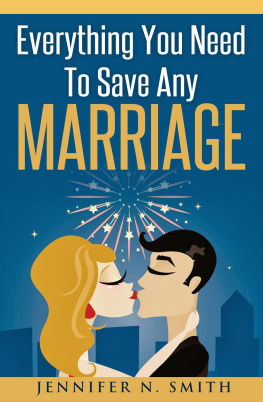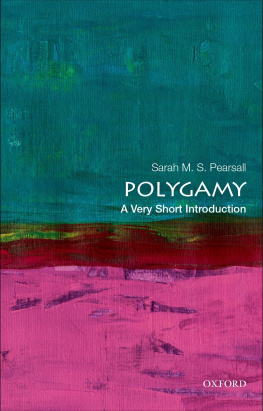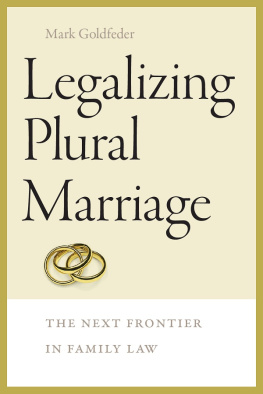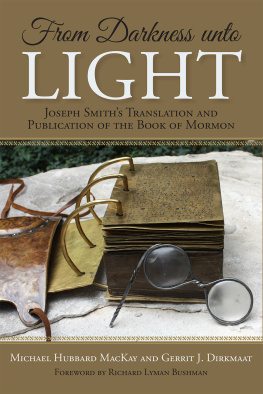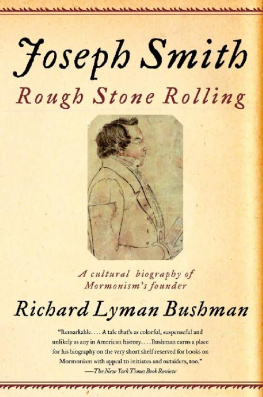2013 by University Press of Colorado
Published by Utah State University Press
An imprint of University Press of Colorado
5589 Arapahoe Avenue, Suite 206C
Boulder, Colorado 80303
| The University Press of Colorado is a proud member of The Association of American University Presses. |
The University Press of Colorado is a cooperative publishing enterprise supported, in part, by Adams State University, Colorado State University, Fort Lewis College, Metropolitan State University of Denver, Regis University, University of Colorado, University of Northern Colorado, Utah State University, and Western State Colorado University.
All rights reserved
Manufactured in the United States of America
Cover design by Dan Miller
ISBN: 978-0-87421-917-3 (cloth)
ISBN: 978-0-87421-918-0 (ebook)
Complete cataloging information for this title is available from the Library of Congress.
Introduction
B RIGHAM YOUNG, FAMOUSLY ACKNOWLEDGED AS THE MOST MARRIED man of the nineteenth century, stated that he was not enthused about entering into polygamy when the principle was first introduced to him in 1841 by Joseph Smith Jr. Young later remembered:
Some of my brethren know what my feelings were at the time Joseph revealed the doctrine; I was not desirous of shrinking f[rom] any duty, nor of failing in the least to do as I was commanded, but it was the first time in my life that I had desired the grave, and I could hardly get over it for a long time and when I saw a funeral, I felt to envy the corpse its situation, and to regret that I was not in the coffin and I have had to examine myself from that day to this, and watch my faith, and carefully mediate lest I should be found desiring the grave more than I ought to.
Most people who recalled Smith approaching them about plural marriage between 1841 and 1844 shared Brighams initial reaction to polygamy. Young remembered one council where Joseph undertook to teach the brethren and sisters. William Law, Smiths counselor in the First Presidency of the church, declared, If an angel from heaven was to reveal to me that a man should have more than one wife, and if it were in my power I would kill him. As Young noted, That was pretty hard, but Joseph had to submit for it. The brethren were not prepared to receive the doctrine.
Women, predictably, were even more reluctant to embrace polygamy than men. Rachel Emma Woolley Simmons was a young child in Nauvoo when polygamy was first broached to her parents, Edwin and Mary Woolley. She recalled that afterward, we saw very little of Mother There would be days together that she would not leave her room. Often I have gone there and found her crying as though her heart would break. Marys crying did no good, however, because Edwin soon married two other women. Before Mary died in 1859,
Lawrence Foster has observed that in almost all recorded cases, initial presentation of the belief in plural marriage to either men or women produced shock, horror, disbelief, or general emotional confusion. Faithful Mormons experienced intense inner turmoil, and gossip and rumor rocked Nauvoo. In light of the intense opposition against it and the great tumult it caused in peoples lives, how did polygamy become the favored form of marriage among Mormons for most of the remainder of the nineteenth century? The obvious answer is that the Mormon people believed polygamy was rightthat it was ordained of God. They eventually did follow this principle, but, given their initial adverse reaction, how did Mormons come to accept polygamy as divinely sanctioned? What might have been the motivations for Joseph Smith to introduce polygamy, and what was the process by which people were persuaded to shift their understanding of marriage not only to accommodate polygamy, but to regard it, at least officially, as the ideal form of marriage?
There are no simple answers. The shift from monogamy to polygamy (and eventually back again) was part of a complex process that essentially had three parts, the first of which began even before Joseph Smith was born. In the wake of the American Revolution, democratic and millenarian forms of religion
In such a climate, Mormon converts were primed to accept unusual doctrines like polygamy, butand this is the second componentonly if it were part of a coherent religious narrative. Foster has argued that through their literal approach to the Bible and, in the Mormon case, their belief in Joseph Smith as a prophet who spoke for God, these groups were able to jettison the whole religious and social order that had developed over more than a thousand years and became free to innovate radically in belief and practice.quintessentially American thinking about progress and possibility for mankind. In other words, in order for polygamy to be accepted, it had to be woven into a narrative that people already embraced. Mormons added some new twists, however. They worked to create a utopian family and a kinship-centered Kingdom of God on earth that they could deliver into the hands of Jesus Christ at the end of the millennium.
Third, and more practically, how was polygamy introduced and then integrated into Mormon society? Since Mormons and non-Mormons alike were resistant to this concept, it was initially brought forth secretly, in a process that interacted with the formation of a supporting theological narrative. The aim of this volume is to trace the interplay between the public development of the Mormon theological narrative and the secret introduction and gradual acceptance of polygamy by taking a close look at the formative years for Mormon polygamy, 18411853.
Family and Democratic Millenarian Religion
Gordon Wood and Nathan Hatch have argued that in the wake of the American Revolution, religion developed in strikingly democratic ways that were appealing and available to broad masses of people. Though religious observance seemed lax in the 1790s, this was merely an interim period, when people were in the process of rejecting hierarchies and established forms of religion in favor of lively and egalitarian varieties of worship that moved beyond Jonathan Edwardss First Great Awakening. The Revolution had taught people that they could think for themselves in religion as well as in politics, and the result was forms of Christianity that were more popular, more evangelical, more ecstatic, more personal, more secular, and more optimistic. [The era] combined the past and the present, communalism and individualism, folkways and enlightenment in odd and confusing ways. Religious enthusiasm often took the form of camp meetings and revivals led by preachers and spiritual leaders who had not been educated to become part of the ministry, but rather arose from the people on the basis of their spiritual gifts.
Millenarian beliefs were an essential ingredient of enthusiastic religion in this period. In contrast to entrenched Calvinist views, which placed all control in the inscrutable hands of God, evangelists like Charles Grandison Finney preached that Christians could bring on the millennium in three months if they dedicated their lives to the task.


